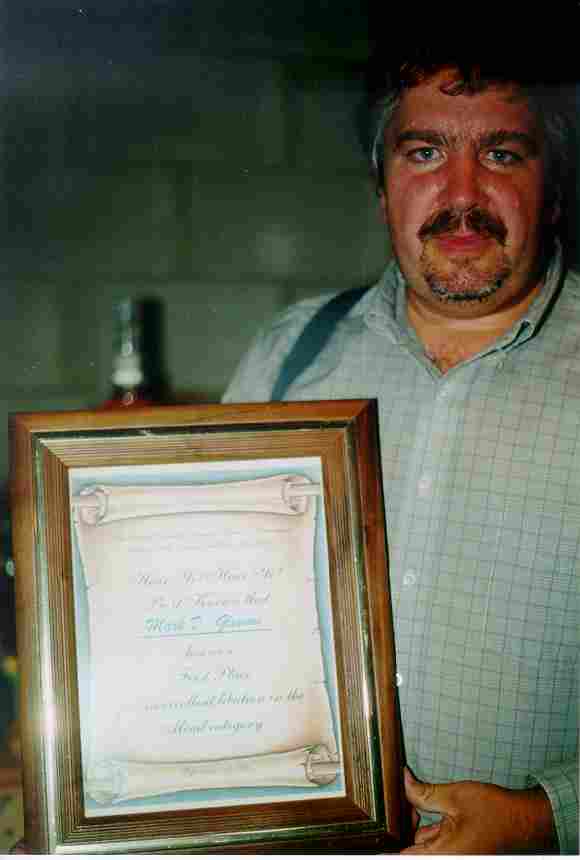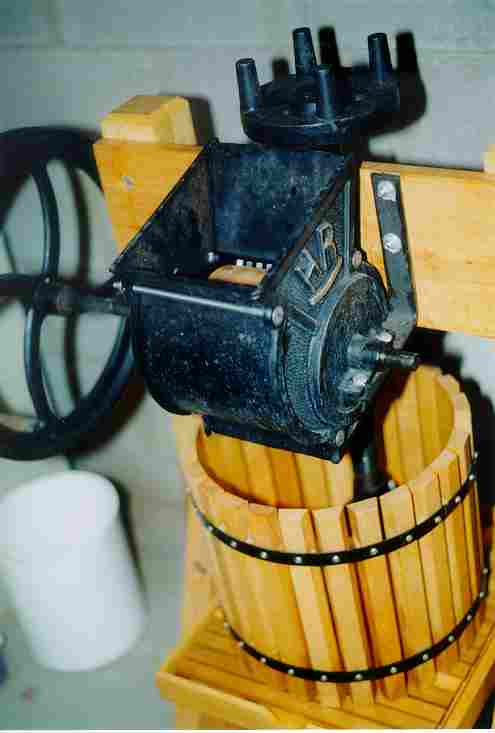By Troy Koester
Staff Writer

Mark Glewwe has been brewing homemade beers, ciders and meads for about six years. He has won a number of awards, and his brews are the hit at the neighborhood gatherings. (Photo by Troy Koester)
Mark Glewwe couldn’t figure out what had happened to his first home-brewed batch of mead, a honey-based wine more common by name on this country’s coasts.
It was in 1994. Glewwe had been intrigued about brewing his own beers and wines for some time but didn’t take his interest seriously until his cousin showed him just how easy it was.
"I started by making a simple brown ale," Glewwe recalled. "Some people at least said they liked it, so it was successful."
Glewwe’s first attempt at making mead wasn’t as successful, or so he thought. While in Canada, he stumbled across the formula for making mead: honey, tannin and acids. He gave it a try then waited three months to give it a taste. It was awful. He tried it again a short time later. Still awful.
He figured he’d done something wrong in the brewing process, and he entered it in the Renaissance Festival’s mead competition more than a year later. The festival plays host to one of the few mead competitions in the area, and Glewwe was hoping he’d "finally get some intelligent feedback on what happened."
A short time later he was a first-place winner, the first of 16 awards he has claimed to date. "This is stupid," he thought, recalling the disgust his drink had cast upon him during earlier samplings.
It was more than a year later. When he returned home with his first place award and his mead, he gave it another try. "It had changed drastically sitting in that basement," he said.
Six years later he earned another award, capturing first-place honors at this year’s Minnesota State Fair in the sparkling wine category. It’s a little deceiving, Glewwe explains, because his sparkling wine is actually a sparkling mead.
"You learn to be extremely patient," said Glewwe. "Mead can correct itself."
Bob Cavill, also of Prior Lake, earned first place in the 100 percent Minnesota white grape table wine competition. Cavill was out of the country and unavailable for an extensive interview.
The wines are judged for looks, taste, smell and balance by three judges.
|
Wine or mead A wine is made with grapes, mead with honey. Glewwe brews about 20 gallons of mead a year, five at a time. Each consists of 15 pounds of honey, nearly four gallons of water, and a mixture of acid and tannin. Tannin is the bitter flavor that is found in grape skin. The flavor of the mead is dictated by the type of honey used, he said. Apple honey is the most common, but clover honey, buckwheat, orange blossom and raspberry blossom are also available. Glewwe’s favorite was the raspberry blossom, but he found that six pounds generated just two gallons of drink. Glewwe has tried different methods with each batch and has documented all of his creations in a notebook dating back to his first experiments in 1994. After heating the honey, water, acid and tannin mixture to kill everything off, the yeast is "pitched" into the "carboy." Pitched is what winemakers do when they add an ingredient; a carboy is a five-gallon container with a pressure release that allows air to escape as the yeast and sugar "play," the word Glewwe coined for the ingredients’ interaction. |
 |
Glewwe’s wife, Laurel, has awakened at night to the sound of gurgling from the bedroom closet. If it gets too cold in the basement, Mark will bring his mead upstairs and hide it in the closet. "It gets too cold for the guys downstairs," Glewwe said, bringing life to the sugar and yeast.
Good tastes
Glewwe belongs to a wine-tasting club in Prior Lake. He has been a judge at a number of beer-tasting competitions. His beverages are a big hit when the rural Spring Lake Township community he calls home has its annual potluck gathering. He figures his capital investment hasn’t exceeded much more than the $50 he spent initially. He continues to look for unusual bottles for his products, and with the help of his wife, he has started using fancy labels.
He won’t call himself a connoisseur, but his taste expertise is easily recognized. He explains that wines are best tasted in the front of the mouth, while beers and meads are best sampled in the back.
"I’ve always been a little more picky about beers," said Glewwe, who is not a heavy drinker. "I’ve always been interested in trying different things."
First-time winners
Bob Cavill and his partner, Obert Tuste, have been brewing red and white wines with Minnesota grapes since 1994. It was the first time they have entered into a contest, and Cavill said he was surprised by the results, a first place in the 100 percent Minnesota grapes white wine competition.
"I was disappointed because I thought our red wine was very good," Cavill said. The red wine took third place.
The grapes they grow are adaptable to Minnesota’s climate. Unlike a French grape, the vines don’t need to be buried to survive a Minnesota winter, and they will automatically reproduce in the spring.
Grape skins are left on when making red wines while white
wines utilize just the juice. The red wines become better with age, according
to Cavill, while the white wines don’t require aging.